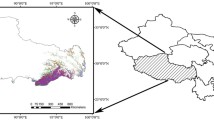Abstract
China’s forests are characterized by young forest age, low carbon density and a large area of planted forests, and thus have high potential to act as carbon sinks in the future. Using China’s national forest inventory data during 1994–1998 and 1999–2003, and direct field measurements, we investigated the relationships between forest biomass density and forest age for 36 major forest types. Statistical approaches and the predicted future forest area from the national forestry development plan were applied to estimate the potential of forest biomass carbon storage in China during 2000–2050. Under an assumption of continuous natural forest growth, China’s existing forest biomass carbon (C) stock would increase from 5.86 Pg C (1 Pg=1015 g) in 1999–2003 to 10.23 Pg C in 2050, resulting in a total increase of 4.37 Pg C. Newly planted forests through afforestation and reforestation will sequestrate an additional 2.86 Pg C in biomass. Overall, China’s forests will potentially act as a carbon sink for 7.23 Pg C during the period 2000–2050, with an average carbon sink of 0.14 Pg C yr−1. This suggests that China’s forests will be a significant carbon sink in the next 50 years.
Similar content being viewed by others
References
Dixon R K, Brown S, Houghton R A, et a1. Carbon pools and flux of global forest ecosystem. Science, 1994, 262: 185–190, 10.1126/science.263.5144.185
Chinese Ministry of Forestry. Forest Resource Statistics of China (1999–2003) (in Chinese). Department of Forest Resource and Management, Chinese Ministry of Forestry, 2005
Fang J Y, Guo Z D, Piao S L, et al. Terrestrial vegetation carbon sinks in China, 1981–2000. Sci China Ser D-Earth Sci, 2007, 50: 1341–1350, 10.1007/s11430-007-0049-1, 1:CAS:528:DC%2BD2sXht1yiurrO
Fang J Y, Wang G G, Liu G H, et al. Forest biomass of China: An estimate based on the biomass-volume relationship. Ecol Appl, 1998, 8: 1084–1091
Fang J Y, Chen A P, Peng C H, et al. Changes in forest biomass carbon storage in China between 1949 and 1998. Science, 2001, 292: 2320–2322, 10.1126/science.1058629, 1:CAS:528:DC%2BD3MXkslShtr4%3D, 11423660
Pan Y D, Luo T X, Birdsey R, et al. New estimates of carbon storage and sequestration in China’s forest: Effect of age class and Method on inventory-based carbon estimation. Clim Change, 2004, 67: 211–236, 10.1007/s10584-004-2799-5, 1:CAS:528:DC%2BD2MXitlKhs7c%3D
China forestry sustainable development strategy research group. General view of China forestry sustainable development strategy research (in Chinese). Beijing: China forestry publishing house, 2002
Pregitzer K S, Euskirchen E S. Carbon cycling and storage in world forests: biome patterns related to forest age. Glob Change Biol, 2004, 10: 2052–2077, 10.1111/j.1365-2486.2004.00866.x
Zhao M, Zhou G S. Estimation of biomass and net primary productivity of major planted forest in China based on forest inventory data. For Ecol Manag, 2005, 207: 295–313, 10.1016/j.foreco.2004.10.049
Kauppi P E, Ausubel J H, Fang J Y, et al. Returning forests analyzed with the forest identity. Proc Natl Acad Sci USA, 2006, 103: 17574–17579, 10.1073/pnas.0608343103, 1:CAS:528:DC%2BD28Xht1Ogsb%2FL, 17101996
Wang X K, Feng Z W, Ouyang Z Y. The impact of human disturbance on vegetative carbon storage in forest ecosystems in China. For Ecol Manag, 2001, 148: 117–123, 10.1016/S0378-1127(00)00482-5
Piao S L, Fang J Y, Zhu B, et al. Forest biomass carbon stocks in China over the past 2 decades: Estimation based on integrated inventory and satellite data. J Geophy Res, 2005, 110, G01006, doi: 10.1029/2005JG000014, 10.1029/2005JG000014
Piao S L, Fang J Y, Ciais P, et al. The Carbon balance of terrestrial ecosystems in China. Nature, 2009, 458: 1009–1013, 10.1038/nature07944, 1:CAS:528:DC%2BD1MXkvFKhtLc%3D, 19396142
Guo Z D, Fang J Y, Pan Y D, et al. Inventory-based estimates of forest biomass carbon stocks in China: A comparison of three methods. For Ecol Manag, 2009, 259: 1225–1231, 10.1016/j.foreco.2009.09.047
Fang J Y, Oikawa T, Kato T, et al. Biomass carbon accumulation by Japan’s forests from 1947 to 1995. Glob Biogeo Cyc, 2005, 19, GB2004, doi: 10.1029/2004GB002253., 10.1029/2004GB002253
Xiao X W, eds. Forest Resource Inventory of China (in Chinese). Beijing: China Forestry Publishing House, 2005
Mickler R A, Earnhardt T S, Moore J A. Regional estimation of current and future forest biomass. Environ Pollut, 2002, 116: S7–S16, 10.1016/S0269-7491(01)00241-X, 1:CAS:528:DC%2BD38XhsFaq, 11833920
Zhao M F, Xiang W H, Peng C H, et al. Simulating age-related changes in carbon storage and allocation in a Chinese fir plantation growing in southern China using the 3-PG model. For Ecol Manag, 2009, 257: 1520–1531, 10.1016/j.foreco.2008.12.025
Hyvonen R, Agren G I, Linder S, et al. The likely impact of elevated CO2, nitrogen deposition, increased temperature and management on carbon sequestration in temperate and boreal forest ecosystems: a literature review. New Phytol, 2007, 173: 463–480, 10.1111/j.1469-8137.2007.01967.x, 17244042
Ju, W M, Chen J M, Harvey D, et al. Future carbon balance of China’s forests under climate change and increasing CO2. J Environ Manag, 2007, 85: 538–562, 10.1016/j.jenvman.2006.04.028, 1:CAS:528:DC%2BD2sXhtlertL3O
Luyssaert S, Inglima I, Jung M, et al. CO2 balance of boreal, temperate, and tropical forests derived from a global database. Glob Change Biol, 2007, 13: 2509–2537, 10.1111/j.1365-2486.2007.01439.x
IPCC. Climate Change 2007: The physical scientific basis. The Fourth Assessment Report of Working Group. Cambridge: Cambridge University Press, 2007
Raupach M R, Marland G, Ciais P, et al. Global and regional drivers of accelerating CO2 emissions. Proc Natl Acad Sci USA, 2007, 104: 10288–93, 10.1073/pnas.0700609104, 1:CAS:528:DC%2BD2sXmvVCmsL0%3D, 17519334
Consulting Special Report, Chinese Academy of Sciences. The scientific basis and propose of Copenhagen climate change negotiation in 2009 (in Chinese), 2009
Author information
Authors and Affiliations
Corresponding author
Rights and permissions
About this article
Cite this article
Xu, B., Guo, Z., Piao, S. et al. Biomass carbon stocks in China’s forests between 2000 and 2050: A prediction based on forest biomass-age relationships. Sci. China Life Sci. 53, 776–783 (2010). https://doi.org/10.1007/s11427-010-4030-4
Received:
Accepted:
Published:
Issue Date:
DOI: https://doi.org/10.1007/s11427-010-4030-4




